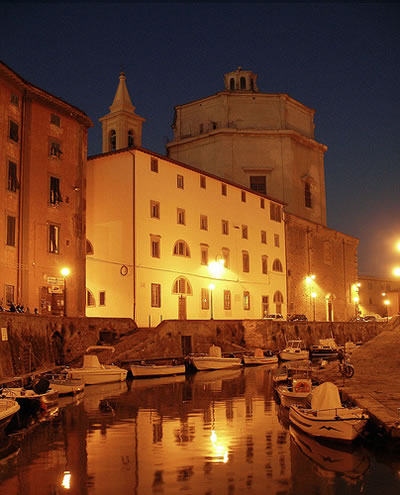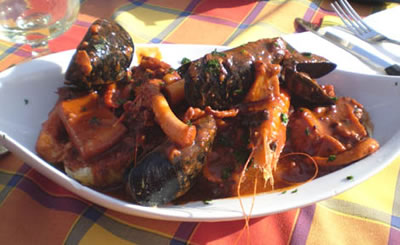Undiscovered Tuscany
Culinary Travel Adventures While Exploring the Etruscan Coast
Articles and Photos by Ilaria Miele

|
|
The Battello in Livorno, on the Etruscan coast away from the tourist hordes who populate many towns and cities in Tuscany.
|
Instead of touring the much traveled hills of the Chianti or the crowded streets of Florence, Siena, and San Gimignano, direct your steps — and car — to the Tuscan coast. Here you will find a corner of Tuscany that is still little known to American tourists but is an essential part of this “mythic” province of Italy.
It is called the “Etruscan Coast.” You will find Etruscan tombs near beaches extending from Livorno to Piombino — the most extensive of which can be found on the Golfo di Baratti. It is a rocky coast punctuated by long sandy beaches and bordered by forests of umbrella pines, orchards, olive groves as well as vineyards.
For wine lovers, just up from the sea, go to the lovely ancient village of Bolgheri with its many “cantine,” where you can taste a superb wine for which the area has lately become famous. Though locals have been drinking good wine for generations, since 1970, in the hills around Bolheri and its sister village of Castagneto Carducci, a new generation of wine makers has planted Cabernet, Syrah, and Merlot together with Sangiovese and, in forty years, produced one of the most extraordinary wines of Italy. Bolgheri has become known as “the little Bordeaux” — something no one could have predicted twenty years ago. The most famous of the vineyards are Sassicaia and Ornellaia, which are called by experts the Ferrari or Lamborghini of wine!
And then there is the sea. On the many wide sandy beaches, you are miles away from the crowds of tourists lining up for a gelato in San Gimignano or waiting to enter the Uffizi. Here you can stroll for miles along the sea in the shade of umbrella pines and listen to the sounds of crickets rather than the hawkers of souvenirs. It is in this atmosphere that composers like Mascagni and painters like Modigliani were born and grew up among a population of peasant farmers, fisherman, and sailors known for their pain-speaking and stubbornness.
Next, go to the port city of Livorno, called Leghorn by the British. Though not well known for its artistic wonders, it is nonetheless a place where you will encounter popular culture not catering to tourism. Built by the Medici for use as their main port, since the 1600’s it has seen everything, from religious and political exiles from all over Europe to notorious bandits, mixing with a resident population of merchants and sailors. But most of all Livorno is known for its cuisine. Just enter one of the many trattorie in Venezia, the historical center of the city, where workers sit under an awning drawn down over the entrance and play cards while they drink wine. The chef is probably the son of fishermen and goes out every morning to the market to select the freshest fish and seafood. From this he makes the most notable dish of Livorno, called the “Cacciucco” (which means “little pieces”) on par with the French Bouillabaisse as one of the most delicious dishes of the Mediterranean. Cacciucco takes a long time to make. First the savory broth composed of fish and tomatoes is cooked for a good 30 minutes, passed through a strainer and only then additional fish and seafood are added. When it is finished cooking slices of toasted bread are placed in each individual plate.

|
|
Cacciucco, a Livornese culinary treat which is like a French Bouillabaisse — loaded with great tastes.
|
Another specialty is “baccala alla Livornese” — salt cod, long a staple before refrigeration — fried with garlic and finished with tomato sauce.
The area of Livorno is not called Venezia for nothing. It is riddled with canals which empty into the sea. If you are still hungry after your Cacciucco — that is, if you have a BIG appetite — and you decide to stroll along the sea walls you will find shops or stands that sell a “torta de ceci,” made with chickpea flour, olive oil, and liberal amounts of salt and pepper, a “street food” common all across the Mediterranean from Nice to Morocco. The “torta” is cooked like crepe in a wood oven and cut into slices to be eaten very hot.

|
|
Torta de ceci.
|
Before leaving Livorno, stop at the ancient “Bar Civili” next to the railway station. Like a bar that you might have seen in old Italian movies, you’ll find men paying cards and drinking little glasses of something called “Ponce alla Livornese,” taken from the English word for punch, and brought to Livorno in the 1600’s by British sailors. It consists of a potent mixture of coffee, rum, sugar, and lemon rind and is considered to be a cure-all. The poor, who could not afford a doctor, used it for that very purpose. Today it is THE drink of Livorno.

|
|
Ponce alla Livornese.
|
The Etruscan Coast is the Italy that many tourists miss. Here you can enjoy the “dolce vita” without the crowds. Of course to take full advantage of this magical place you’ll need to stay in an agriturismo, usually found in the hills within easy reach of the sea.
IlARIA MIELE was born in Tuscany in 1983, graduated in "Media and Journalism" in Florence. Her family has been Tuscan for generations and she is an absolute food-lover. Her grandma used to cook for a noble family in Colle Val d'Elsa almost 60 years ago and many members of her family have worked with wine and food, managing restaurants or working in wineries. That's why Ilaria likely has such a passion for gastronomy and wine!
Ilaria opened her own restaurant with other friends two years ago and along with it keeps cultivating her other huge passion which is writing; she is currently a freelance writer for different Tuscan web magazines. She loves nature, food, and travel: Ilaria usually spends her spare time traveling all over Italy for tastings and exploring small farms and lesser-known places.
|
